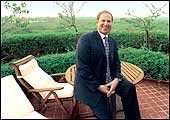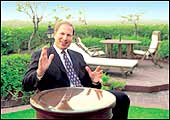 |
It
is a 149-year old $22.3 billion behemoth with a presence in businesses
from aerospace to control systems, specialty chemicals to transportation,
and safety solutions to power systems. Yet, most people remember
Honeywell for its failed merger with GE around the turn of the century,
than for anything else (even the successful merger with Allied Signal
has been forgotten). Former GE hand and former Allied Signal CEO
Larry Bossidy ran the firm for some time after its failed merger
but it was evident that he was a stand-in. So, it was no surprise
to anybody when the company hired
David M. Cote, another former GE veteran—he worked
in the company for 25 years and left it when he was CEO of its appliances
business—who was CEO of TRW, as its CEO in February 2002 (he
was named chairman in July the same year). Since then, Cote has
been steering the company back to profits, a task that should see
its culmination in 2003. On a recent visit to India, Cote met with
Business Today. Excerpts from the interview:
This is your second visit to India after
you took over as CEO. What brings you here again?
Opportunity. This is a big potential market
for us; we already have a very good presence here. It looks like
a great place for us to be able to expand. We only do around $75
million (Rs 352.5 crore) in sales in India today but we are doing
a great job in other areas like software and engineering. In Bangalore,
we had about 500 people about 15 months ago. Today, we have close
to 1,500, and we'll have close to 2,000 by the end of the year.
There's just a lot more that I think we can do here.
Things weren't exactly going very well for
Honeywell when you signed on last year. What kind of company did
you inherit?
 |
| "We have a great suite
of businesses. We have great technologies. A lot of trends out
there help us" |
We went through two or three years of real,
er, turmoil. We had the combination between legacy Honeywell and
Allied Signal. Then we had the UT merger. Then the GE merger.. the
failure of the GE merger. Followed by the departure of the then
CEO. The return of the former CEO. September 11. The recession.
And then me (laughs).
One of my concerns walking in the door was
that I would find a dispirited company. I was concerned that people
would be thinking, "We don't need one more thing." So
I spent a lot of time in that first two or three months getting
around and doing town hall meetings across the US, Mexico, Asia,
and Europe, getting feedback, and doing some cheerleading. To tell
people, "We can do this."
We have a great suite of businesses. We have
great technologies. A lot of trends out there help us: people are
concerned about global warming and ozone depletion, all things we
have products for.
It was really interesting that the message
I came back with was, "Hey, Dave, we are ready to go, just
give us some direction."
Most new CEOs have themes for their organisations. Do you have
any for Honeywell?
We talk about our five initiatives a lot. Our
initiatives are growth, productivity, cash, people, and our enablers,
digital works and Six Sigma. Doing more with less every year has
been a constant refrain for the company and is one we want to make
sure we stay committed to. We've got over $2 billion in cash on
the balance sheet today, and we'll generate an additional billion
this year and at least that much every year after. We look at people
as the ultimate differentiator. By the end of the year, we will
have 60,000 people trained in Six Sigma. And we are trying to design
perfection into our products from the very beginning using Design
For Six Sigma (DFSS). We will have 100 per cent of our engineers
trained by June 30. Every business is developing a growth process-one
that generates ideas, selects them, develops them, and then decides
whether it is kiss or kill.
The second big piece of the growth drive is
what we call the four pillars of growth. That may sound prosaic,
but they are more powerful in implementation than people realise.
The first is doing a superb job for our customers every day in technology,
quality, delivery, and value. Companies underestimate the importance
of that as a growth effort, but also generally overestimate how
good they are at it. The second pillar is having a superior sales
and marketing organisation. Today, as a company we are driven more
as a finance, technology, and manufacturing organisation-we need
to have a much more developed commercial function. The third is
globalisation, which is exactly what it sounds like. It is the sort
of thing that brings me to India. The fourth is having robust funded
technology roadmaps for new products and services, all supported
by Design For Six Sigma.
How would you describe the culture at Honeywell? Is it very similar
to that at GE where you spent a large part of your career?
The thing that I really liked about the Honeywell
culture is that it is very execution-oriented. If you ask people
to do something and explain what you are trying to do, it just gets
done. That causes you to have a little bit of caution also because
you got to pick the right thing. And morale is good.
How important is India to Honeywell? Where does it fit into the
plans you have?
Right now it is very important if you are speaking
of software engineering. When it comes to sales, that's an under-developed
area for us. We have to pay lot more attention to it. That's one
reason why I visited the country 12 months ago and am here again-to
get a better handle of what we have to do.
And China?
China is an important growth market for us.
We have lots of sales there-a good chunk of it is exports, but there
is also internal usage. I am impressed with the changes I have seen
in China with every visit. It keeps getting better and better.
According to a recent article in Fortune
magazine, although your company's returns were below the S&P's,
you earned $68.5 million last year. What do you have to say to this?
I guess it is important to consider a couple
of factors. If you are in a company for 20 years, you accumulate
a lot of things. Stock options, restricted stock... and in the 20th
year when you become CEO none of that counts. For any of the public
reporting, none of that counts. If you are a CEO who goes to a new
company, that 20-year tale, you are not going to walk away from
that. At the same time, the company you are leaving is not going
to say, "It was great knowing you Dave; we are going to give
you the money anyway." So, the new company you are going to
has to make up the difference. The way it gets reported in the press,
all that is counted in the total. I will have a significant drop
in my pay next year, when nothing has really changed.
Second, the report makes it sound like I got
the money. Fact is (the part of it that is in the form of stock
options) vests over time. And the whole point is, I don't go anywhere.
I have to be there to get that.
Third, stock options in that report were valued
at $30 million (Rs 141 crore) or $31 million (145.7 crore). Fact
is, those stock options were at a strike price of $34. The current
stock price is $22 (Rs 1,034). Right now, they're worth nothing.
If they are worth $31 million, the stock price needs to be around
$49 (Rs 2,303). That $49 versus the $22 adds about $22 billion (Rs
1,03,400 crore) to $23 billion (Rs 1,08,100 crore) in market value.
From the strike price of $34 (Rs 1,632) it is a $14 billion (Rs
65,800 crore) increase in market value. So, if I do the right thing,
and add around $14 billion in market value, that's when the options
are worth $31 million. I don't think that's quite so outrageous.
|

